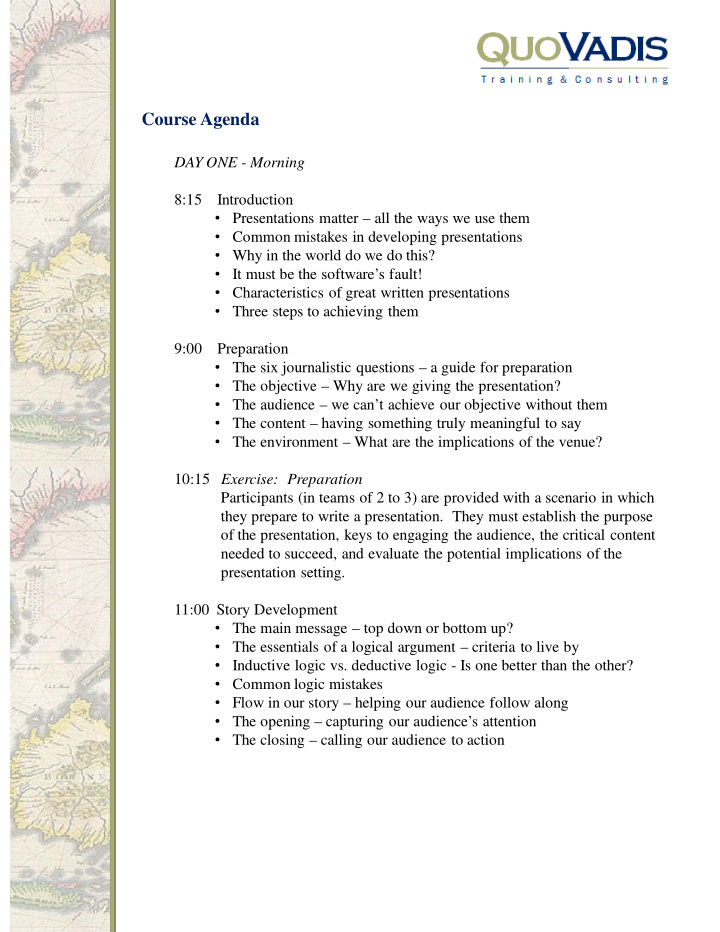



Course Agenda DAY ONE - Morning 8:15 Introduction • Presentations matter – all the ways we use them • Common mistakes in developing presentations • Why in the world do we do this? • It must be the software’s fault! • Characteristics of great written presentations • Three steps to achieving them 9:00 Preparation • The six journalistic questions – a guide for preparation • The objective – Why are we giving the presentation? • The audience – we can’t achieve our objective without them • The content – having something truly meaningful to say • The environment – What are the implications of the venue? 10:15 Exercise: Preparation Participants (in teams of 2 to 3) are provided with a scenario in which they prepare to write a presentation. They must establish the purpose of the presentation, keys to engaging the audience, the critical content needed to succeed, and evaluate the potential implications of the presentation setting. 11:00 Story Development • The main message – top down or bottom up? • The essentials of a logical argument – criteria to live by • Inductive logic vs. deductive logic - Is one better than the other? • Common logic mistakes • Flow in our story – helping our audience follow along • The opening – capturing our audience’s attention • The closing – calling our audience to action
Course Agenda DAY ONE - Afternoon 1:00 Exercise: Developing the story Participants must develop a main message and support it convincingly with a comprehensive, logical story outline. A draft presentation is given to provide content to the teams for use in their stories. Participants will find that it contains more information than needed, giving them practice at paring a presentation down to its essential messages. 2:00 Visual Design • The anatomy of a PowerPoint page • Storyboards – converting a word outline into a graphical outline • Types of visuals – the choices we have, the pros and cons of each – Text visuals – when specific words matter – Concept visuals – a picture tells a 1,000 words – Tables – for those who really must see the actual data – Charts – the better means for displaying quantitative info � Zelazny’s guidance on charts � Tufte’s key contribution • Headlines – telling the story with clarity and impact 4:00 Exercise: Writing the presentation Participants develop a Powerpoint presentation from the story outline developed earlier in the day. They may use material from the draft presentation provided, although they will find doing so requires a fair amount of editing. The final presentation is typically 10 to 12 Powerpoint slides, thus each participant develops three to four slides, then work with his or her team to develop a cohesive, final presentation. This exercise is given as homework and continues into the following morning.
Course Agenda DAY TWO 8:30 Review of day one 8:45 Exercise: Writing the Presentation (continued from previous day) Participants are given time to integrate their individual pages into a final team presentation. 10:30 Review of presentations Each team shares their final presentation and walks through the logic of their story and intent of their visual design. This is a highly interactive, working session focused on the written document, NOT the team’s verbal presentation skills. Through this exercise team members are exposed to alternative ways to organize and present ideas and ways to overcome the common challenges of presentation writing. 12:00 Review and wrap up
Recommend
More recommend